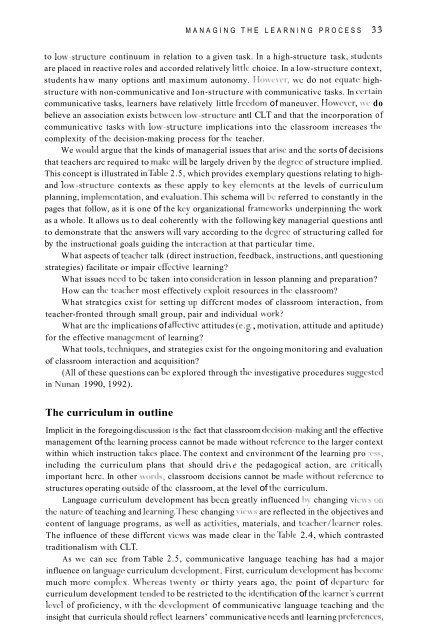Download - Search
Download - Search
Download - Search
You also want an ePaper? Increase the reach of your titles
YUMPU automatically turns print PDFs into web optimized ePapers that Google loves.
MANAGING THE LEARNING PROCESS 33to Ion-structure continuum in relation to a given task. In a high-structure task, studentsare placed in reactive roles and accorded relatively little choice. In a low-structure context,students haw many options antl maximum autonomy. EIomww-, ~ vc do not equate highstructurewith non-communicative and Ion-structure with communicativc tasks. In ccrtaincommunicative tasks, learners have relatively little freedom of maneuver. Howcvcr, ~ vc dobelieve an association exists bctwecn lolv-structure antl CLT and that the incorporation ofcommunicativc tasks Lvith Ion-structure implications into the classroom increases thtcomplexityof the decision-making process for the teacher.We \vould argue that the kinds of managerial issues that arise and the sorts of decisionsthat teachers arc required to make will be largely driven by the degrcc of structure implied.This concept is illustrated inTablc 2.5, which provides exemplary questions relating to highandloM--structure contexts as these apply to key elemcnts at the levels of curriculumplanning, implemcntation, and evaluation.This schema will be referred to constantly in thepages that follow, as it is one of the key organizational framcworks underpinning the workas a whole. It allows us to deal coherently with the following key managerial questions antlto demonstrate that the answers \.rill vary according to the tlcgrec of structuring called forby the instructional goals guiding the intcraction at that particular time.What aspects of tcachcr talk (direct instruction, feedback, instructions, antl questioningstrategies) facilitate or impair cffcctive learning?What issues nccd to bc taken into consideration in lesson planning and preparation?How can the tcacher most effectively cxploit resources in the classroom?What stratcgics cxist for setting up diffcrcnt modes of classroom interaction, fromteacher-fronted through small group, pair and individual Lvork?What arc the implications of affective attitudes (e.g., motivation, attitude and aptitude)for the effective managcmcnt of learning?What tools, tcchniques, and strategies cxist for the ongoing monitoring and evaluationof classroom interaction and acquisition?(All of these questions can be explored through thc investigative procedures suggestedin Nunan 1990, 1992).The curriculum in outlineImplicit in the foregoing discussion is thc fact that classroom dccision-making antl the effectivemanagement of thc learning process cannot be made without rcfcrcncc to the larger contextwithin which instruction takcs place. The context and cnvironmcnt of the learning proincluding the curriculum plans that should tlri\ e the pedagogical action, arc criticall!important hcrc. In other \vortls, classroom dccisions cannot be made \vithout rcfcrcncc tostructures operating outsidc of the classroom, at the level of the curriculum.Language curriculum development has been greatly influenced by changing vithe naturc of teaching and learning.’l’hesc changing viclvs are reflected in the objectives andcontent of language programs, as well as acti\ities, materials, and tcachcr/lcarner roles.The influence of these diffcrcnt viovs was made clear in the Table 2.4, which contrastedtraditionalism nith CLT.As hve can sec from Table 2.5, communicative language teaching has had a majorinfluence on languagc curriculum dcvclopment. First, curriculum tlcvclopmcnt has hccomcmuch morc complcx. Whereas txvcnty or thirty years ago, thc point of tlcparturc forcurriculum development trntlrd to be restricted to the identification of the Icarncr’s currrntlcvcl of proficiency, \z ith thc dcvelopmcnt of communicativc language tcaching and thcinsight that curricula should reflect learners’ communicative ncetls antl learning prcfcrcnccs,


